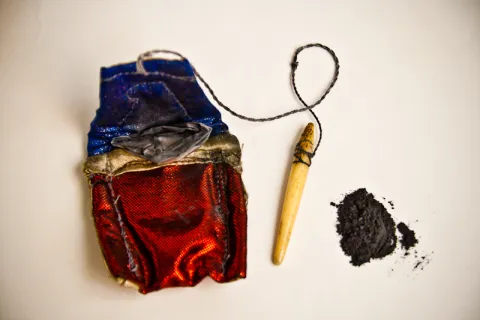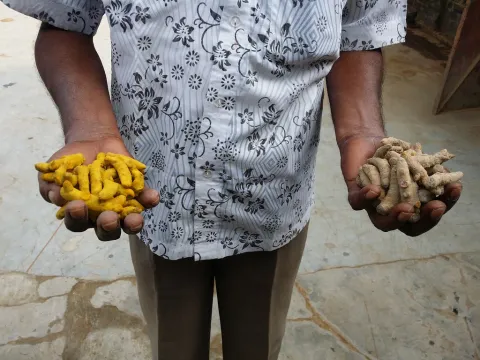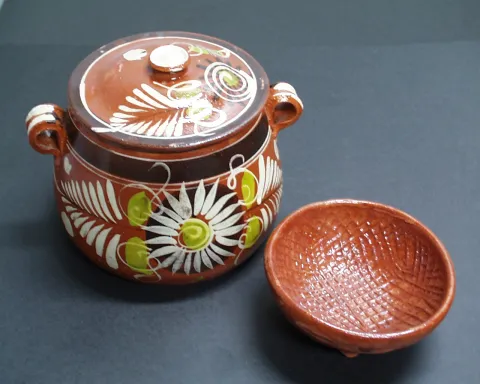Lead paint is the main cause of lead poisoning in children. However, high amounts of lead have been found in certain cultural items, including:
- Kohl, kajal, surma, sormeh (black eye powder)
- Hindu colored powders (sindoor, kumkum, tikka)
- Turmeric
- Mexican pottery
Consuming even small amounts of lead can be harmful and cause lead poisoning.
You can’t tell if something contains lead simply by looking at it.
What You Can Do
Our cultural traditions are important. They build strong family bonds across generations and give us a sense of belonging.
If you use these items, you should get them tested for lead by a lab. Call us at 503-988-4000 for more information.
You can also use a lead-free alternative.
You can check your family for lead poisoning with a simple blood test. Talk to your doctor, or call us at 503-988-4000 to talk about testing options.
Kohl, Kajal, Surma, Sormeh, Athmad or Ithmid

Kohl, a black powder used in the Middle East, South Asia and the Horn of Africa, may contain high levels of lead. In Multnomah County, we have found lead in kohl purchased locally and abroad.
Kohl is used as a traditional eyeliner and is highly valued for spiritual, medicinal and cosmetic qualities. It’s commonly made by grinding a mineral called galena (lead ore or lead sulfide) into a powder and mixing it with other ingredients.
You can be exposed to lead when kohl gets on your hands and then in your mouth. This is especially common for children.
If you use kohl:
- Wash hands after handling it
- Keep containers away from children
- Test it for lead (call us at 503-988-4000)
- Use kohl that has been labeled lead-free (made in the U.S., Canada or Europe)
- Test your family for lead. Talk to your doctor or go to a free lead screening»
Posters & Flyers
Hindu Colored Powders
Sindoor, Kumkum, Tikka and Roli

Red, orange and yellow powders used by Hindu communities from South Asia (India, Bangladesh, Nepal) may contain high levels of lead. This includes those purchased locally as well as abroad.
Sindoor and kumkum are applied to the hairline, forehead or face. They’re also used in ceremonies and on holy days. You can be exposed to lead if powder gets in your eyes or mouth.
If you use these powders:
- Wash your hands after you handle them
- Keep containers away from children
- Test it for lead (call us at 503-988-4000)
- Test your family for lead. Talk to your doctor or go to a free lead screening»
Turmeric

Turmeric spice is the main ingredient in curry powder and is used daily in South Asian cuisine. It’s also valued for its health benefits and is used for traditional medicine.
Both the root and powder can contain high levels of lead, which can cause lead poisoning when eaten.
Lead-contaminated turmeric is most often bought in India or Bangladesh. A bright yellow powder that is high in lead is sometimes added to turmeric root or spice to brighten the color.
Health officials are mainly concerned about turmeric that is carried into the country, rather than turmeric sold in major U.S. supermarkets.
If you use turmeric:
- Buy it at a major U.S. supermarket
- Test it for lead (call us at 503-988-4000)
- Test your family for lead. Talk to your doctor or go to a free lead screening»
Mexican Pottery (Barro)
Molcajete, chilmolera, cazuela, Olla de barro

Barro is a traditional hand-made pottery found in some parts of Mexico, Central America and South America. It's used for cooking and serving food and beverages.
Barro may have lead in the glaze, which can contaminate food. You can be exposed to lead if you eat or drink from these dishes.
There is a long tradition of using these dishes, which are passed down through generations. Most of the time, they are brought into the country from abroad.
If you have these dishes:
- Use a lead test swab (inexpensive, from your local hardware store) to test them for lead
- Don't use dishes that contain lead to prepare, cook or serve food or drinks
- Test your family for lead. Talk to your doctor or go to a free lead screening»
More Information
Questions? Call the Leadline at 503-988-4000. Spanish-speaking staff and interpreters in other languages available.
